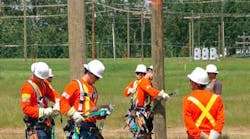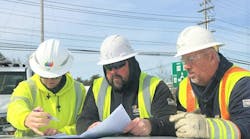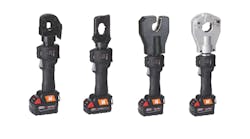Twenty-seven years ago in Alberta, Canada, a lineman fell off a wooden transmission structure and died from his injuries. He was wearing the traditional lineman belt with a single pole strap.
Alberta Occupational Health & Safety (AOH&S), the governing agency that sets the regulatory requirements for fall protection and other industry practices, conducted an investigation, after which FortisAlberta mandated the use of a secondary pole strap for any transition over an obstacle such as neutral conductor or crossarm. The utility then followed the practice of using the double pole strap until CSA Standard Z259.14-01 Fall Restrict Equipment for Wood Pole Climbing was implemented across Canada.
Since that time, Canadian utilities have been required by AOH&S to outfit their linemen with a fall-restricting device any time they are above 3 meters. In addition to meeting this national requirement, FortisAlberta requires its linemen to wear a second positioning belt any time they cross over an obstruction on the pole. This provides another layer of protection against a fall.
FortisAlberta's linemen rely on a variety of fall-restricting devices such as Miller belts, the Jelco Pole Choker, the Buckingham BuckSqueeze and the Scepter PoleShark. Recently, the company implemented a change to its safety requirements for climbing poles. Now instead of wearing just a lineman body belt, FortisAlberta's linemen must wear a newly developed body belt/harness combination from Buckingham Manufacturing.
Providing Enhanced Protection
About a year ago, AOH&S discussed provincial legislation implementing full-body harnesses for those who climb wooden structures. This change was scheduled to be in effect by 2013. Since that time, AOH&S has decided not to implement full body harness/belt combinations in the new legislation unless the electrical industry requests the proposed change. FortisAlberta believes that this legislation will be mandated to full fall protection in the future, so the company's work methods team was challenged to come up with a solution.
FortisAlberta approached different manufacturers to test their devices, which were mainly bucket/belt combinations. As with any kind of change, the utility experienced push-back from long-time employees about implementing this kind of full-body harness. These employees believed that the new harness would be awkward to use and easy to misuse.
To mitigate any fallout, the company wanted to modify the devices to make them more agreeable to their seasoned veterans. While many of the manufacturing companies didn't want to change their devices, Buckingham agreed to make a harness/belt combination. FortisAlberta employees tested out five prototypes before the custom product was finalized, which is now on the market.
Focusing on Ergonomics
When FortisAlberta looked at the traditional pole-climbing belts, different companies talked about product innovations involving ergonomics. For example, Buckingham brought in a physical therapist to discuss the effect on a user's body when he or she falls in a pole-climbing belt. As a result, the company made an ErgoBelt, which provides lumbar support in the back. Instead of wearing the belt around the hips, users bring the belt up to the curvature of the back.
The company requested that the manufacturer attach the ErgoSeat within the belt so the linemen don't have to use the two dee rings. Modifications to further improve the device are in progress. Another important feature of this fall-protection device is its flame-resistant material. Linemen must wear flame-resistant clothing with a minimum rating of 8 calories, yet Buckingham provided the utility with belt/harness combinations that included a 40-calorie range.
Other companies have transitioned to a harness with a belt over the top, but linemen have found them restrictive and uncomfortable to wear. Buckingham joined the belt and harness together so in the event of a fall, the lineman have a leg strap as part of the harness. That way, the weight is more evenly distributed, rather than all in the middle of the back, it also goes to the legs, preventing an injury.
In the future, FortisAlberta is planning to review pole-top rescue fall-protection devices. The harness/belt combination prevents the need for the linemen to place the belt around the rope. At present, when a victim is rescued, the rescue rope goes under the armpit and across the chest. This procedure relies heavily on the competence of the person tying the knot. When they do it with a harness, it supports the victim's weight in the large part of the leg, making it less likely to cause a fall or an injury.
The harnesses are able to be adjusted to accommodate different hip sizes, which allows the linemen to reach out a long distance once they are tied into a harness. Linemen also can loosen the harness so it won't pull on their shoulders and inflict shoulder injuries.
Training the Field Workforce
FortisAlberta implemented the H-Frame style of harness complete with leg straps. This fall-protection equipment goes over the top of the shoulders and down to the belt with leg straps incorporated. That way if a lineman falls upside down, it doesn't allow the strap to fall off the shoulders, and he or she is still able to use his arms without any restrictions on the shoulders. The harness has a quick-release button on the front for ease of installation. It also has a lanyard attachment on the front and back for rescue or anchoring.
The most challenging aspect for implementing the new fall-protection devices has been the perceived speed with which the linemen are able to perform their duties. Employees want the fall-protection devices to be easy to use and less obstructive. FortisAlberta is currently training employees on a two-belt system. This training is included in the company's “Core Skills Orientation,” which all new linemen and temporary laborers are required to complete.
As part of this training, apprentices are provided with the BuckSqueeze, a secondary positioning belt, and the harness/belt combination. These apprentices, new to the industry, see this device as a single unit rather than a two-belt system, and going forward, they won't see any difference. By starting them out on one device, they won't have a learning curve.
By staying ahead of governmental regulations, the utility is working hard to safeguard the health and safety of its field employees.
Wayne Holmen is a work methods specialist for FortisAlberta. He has been in the trade for 30 years and with the company for 23 years. He worked as a lineman and crew foreman. In his current role, he writes and reviews standards, teaches live-line work and trains journeymen. He is a technical trainer, mentor and safety trainer.
Companies mentioned:
Buckingham Manufacturing Co. Inc.
www.buckinghammfg.com
FortisAlberta | www.fortisalberta.com
Jelco | www.jelcoinc.com
Miller Fall Protection | www.millerfallprotection.com
Scepter | www.poleshark.com





